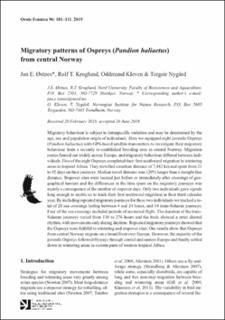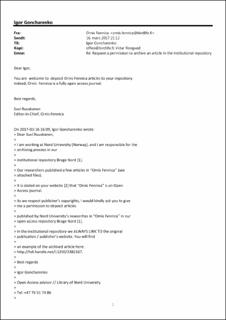| dc.contributor.author | Østnes, Jan Eivind | |
| dc.contributor.author | Kroglund, Rolf Terje | |
| dc.contributor.author | Kleven, Oddmund | |
| dc.contributor.author | Nygård, Torgeir | |
| dc.date.accessioned | 2020-06-18T09:30:54Z | |
| dc.date.available | 2020-06-18T09:30:54Z | |
| dc.date.created | 2019-08-12T14:44:25Z | |
| dc.date.issued | 2019 | |
| dc.identifier.citation | Østnes, J. E., Kroglund, R. T., Kleven, O. & Nygård, T. (2019). Migratory patterns of Ospreys (Pandion haliaetus) from central Norway. Ornis Fennica, 96(3), 101-111. | en_US |
| dc.identifier.issn | 0030-5685 | |
| dc.identifier.uri | https://hdl.handle.net/11250/2658612 | |
| dc.description.abstract | Migratory behaviour is subject to intraspecific variation and may be determined by the age, sex and population origin of individuals. Here we equipped eight juvenile Ospreys (Pandion haliaetus) with GPS-based satellite-transmitters to investigate their migratory behaviour from a recently re-established breeding area in central Norway. Migration routes fanned out widely across Europe, and migratory behaviour differed between individuals. Five of the eight Ospreys completed their first southward migration to wintering areas in tropical Africa. They travelled a median distance of 7,482 km and spent from 21 to 92 days on their journeys. Median travel distance was 120% longer than a straight-line distance. Stopover sites were located just before or immediately after crossings of geographical barriers and the differences in the time spent on the migratory journeys was mainly a consequence of the number of stopover days. Only two individuals gave signals long enough to enable us to track their first northward migration in their third calendar year. By including repeated migratory journeys for these two individuals we tracked a total of 20 sea crossings lasting between 4 and 24 hours, and 14 trans-Saharan journeys. Four of the sea crossings included periods of nocturnal flight. The duration of the trans-Saharan journeys varied from 130 to 276 hours and the birds showed a strict diurnal rhythm, with movements only during daytime. Repeated migratory journeys showed that the Ospreys were faithful to wintering and stopover sites. Our results show that Ospreys from central Norway migrate on a broad front over Europe. However, the majority of the juvenile Ospreys followed flyways through central and eastern Europe and finally settled down in wintering areas in eastern parts of western tropical Africa. | en_US |
| dc.language.iso | eng | en_US |
| dc.publisher | Suomen lintutieteellinen yhdistys | en_US |
| dc.title | Migratory patterns of Ospreys (Pandion haliaetus) from central Norway | en_US |
| dc.type | Peer reviewed | en_US |
| dc.type | Journal article | en_US |
| dc.description.version | publishedVersion | en_US |
| dc.rights.holder | © 2019 The Author(s) | en_US |
| dc.subject.nsi | VDP::Matematikk og Naturvitenskap: 400::Zoologiske og botaniske fag: 480 | en_US |
| dc.source.pagenumber | 101-111 | en_US |
| dc.source.volume | 96 | en_US |
| dc.source.journal | Ornis Fennica | en_US |
| dc.source.issue | 3 | en_US |
| dc.identifier.cristin | 1715337 | |

